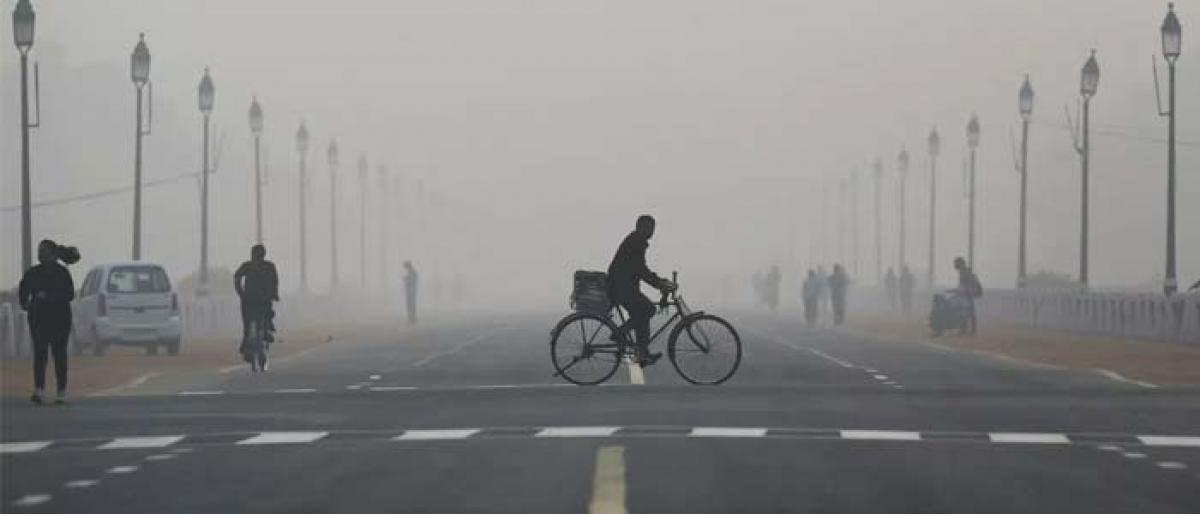Catastrophic warning: Delhi's average temperature spikes 1 degree, Kolkata 1.2 degrees

The average temperature in the national capital increased by one degree Celsius, by 07 degree in Mumbai, 06 degree in Chennai and 12 degrees in Kolkata in over a centuryandahalf
New Delhi: The average temperature in the national capital increased by one degree Celsius, by 0.7 degree in Mumbai, 0.6 degree in Chennai and 1.2 degrees in Kolkata in over a century-and-a-half.
These startling revelations by Britain-based CarbonBrief came when all eyes are on South Korea as scientists discuss stricter cuts on emissions. Its newly-developed web app calculates the average rise in your city and regional temperature since 1871.
The application comes in handy to understand the impact of increase in global temperatures caused by climate change. Heat stress is likely to become increasingly frequent and more intense with increased warming.
Climate experts say such analysis assumes significance when representatives of the 195 member-governments and authors are working long hours to approve the "life changing" report of the UN Intergovernmental Panel on Climate Change (IPCC) scheduled to be published on October 8.
It's believed to be the largest peer-review exercise in the world, as has been noted by an IPCC spokesperson.
Scientists and experts have been in meeting all through the week in Incheon city in South Korea to agree to the report that will offer pathways of keeping the world temperature at 1.5 degrees of warming.
The recommendations could offer scientific guidance to policymakers on how to reduce emissions from sectors like electricity, transport, buildings and agriculture to not exceed global temperature rise of more than 1.5 degrees from pre-industrial levels.
Climate change has already caused global temperatures to rise one degree on an average from pre-industrial levels.
The IPCC report is expected to demonstrate that the cost of action to limit global warming is far less than the massive cost of inaction the world will have to bear in future once runaway climate change sets in.
"India is very vulnerable to the impact of climate change with over 7,000 km of coastline and a huge reliance on our Himalayan glaciers and monsoon rains for the livelihood and well-being of our people," New-Delhi based The Energy Research Institute Director General Ajay Mathur told IANS.
"Supporting and implementing comprehensive and urgent climate action that is required to be taken by all stakeholders to limit temperature rise to well below two degrees Celsius is the need of the hour," he said.
According to a report released by Britain-based Christian Aid, coastal cities like London, Houston, Jakarta and Shanghai are set to become extremely vulnerable to storm surges and flooding.
The rise in sea-level is expected to exceed 40 cm if global warming is not limited to 1.5 degree Celsius.
With the world's urban population expected to grow to 59 per cent by 2030, city-dwellers will increasingly come under threat.
The recent floods in Kerala displaced more than 700,000 people and caused close of 500 deaths.
A recent study published in the Nature Climate Change journal reviewed economies of over 200 countries and concluded that India's would be worst affected by climate change.
By signing the 2015 Paris Climate Change Agreement, India is committed to reducing its carbon emission intensity by 33-35 per cent by 2030 below 2005 levels, increase the share of non-fossil-based energy resources to 40 per cent of the installed electric capacity by 2030 and to create an additional carbon sink of 2.5-3 gigatonnes of CO2e -- carbon dioxide equivalent -- through additional forest and tree cover by 2030.
According to ClimateTracker, India's climate action plan would help limit global temperature rise to two degree Celsius provided other countries also take action.
According to scientists working on the IPCC report, extreme weather events will only increase if global temperatures are not limited within 1.5 degrees Celsius. Warming at present is well over one degree. At current trends, the world could see temperatures rise to well above two degrees by 2065.
Limiting temperature rise to two degrees means sharp reductions in global emissions and the rapid reversal of economic and population growth trends observed the last 50 years.
However, even at two degrees Celsius, extreme weather events such as heatwaves could kill many and cause severe damage to agriculture, cause water shortages, as well as completely melt Arctic sea ice for several months together.
A New Climate Economy report released last month says benefits from moving towards a low carbon economy could be as high as $26 trillion through to 2030 when compared with business as usual.
This means that weaning off coal and fossil fuels could not only help reduce carbon emissions and help limit the global temperature rise but also result in economic benefits.
The report finds that bold climate action could generate over 65 million new low-carbon jobs in 2030, equivalent to today's entire work forces of Britain and Egypt combined.
"Typhoons and floods are not new, but we are seeing a broader pattern of more severe and more frequent extreme weather events," United Nations Environment Executive Director Erik Solheim has said.
"That's what the scientists predicted, and it's what we're seeing play out now right in front of our eyes. Our planet is sending us a clear message. We have to act, and we're a short time-frame to do so before we lose the ability to turn things around," Solheim told IANS in a recent interview.
According to UN Environment's Emissions Gap Report 2017, even if countries fulfill their pledges to limit global warming to under two degrees Celsius, their actions would only represent a third of what is needed to avoid the worst impact of climate change.
The report finds that current Paris pledges make 2030 emissions likely to reach 11 to 13.5 gigatonnes of carbon dioxide equivalent (GT CO2e) above the level needed to stay on the least-cost path to meeting the 2 degrees Celsius target.
One gigatonne is roughly equivalent to one year of transport emissions in the European Union, including aviation.







